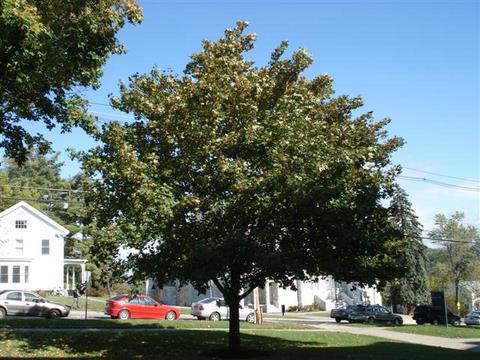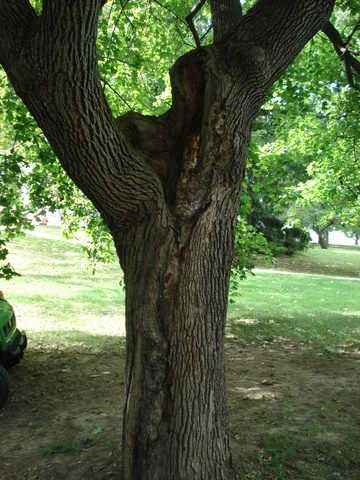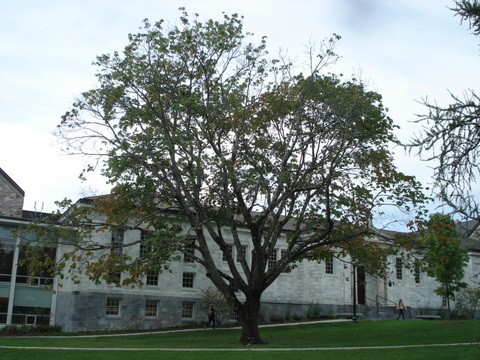Norway Maple, Acer platinoides, flowers attractively in the early spring, late April here, with clusters of yellowish green flowers appearing before the leaves, each flower about ⅓” in size, but held in large clusters called corymbs, completely covering the tree. Norways are actually one of the most attractive early flowering trees. Bright yellow fall color can frequently be seen, in years when Tar spot doesn’t decimate the crown foliage.
The flowers turn into large seed pods called samaras, with a pair of seeds held in the center, and large flat wings spreading to each side. Split in half, and each side will helicopter towards the ground slowly, or alight in a breeze and fly for some distance. The wings of the helicopter extend around the seed, and can be opened like a book, where the milky white sap inside can act like a glue, allowing the samara to be attached to one’s nose, where it can stay stuck until nap time.
This milky white sap is a great way for the confused to identify Norway maples, as the similar sized Sugar and Red (Swamp) maples have a clear sap when broken. Spend some time with them, though, and identification becomes easier. The bark is a dark gray, and is ridged and furrowed, unlike any native maple. The leaves are large and dark green, larger than any other maple around, and while similar to Sugar maple, are flatter at the base.
It’s the leaves that cause many of the problems of the species, a victim of their own success. The size of the leaves create a super dense shade, making growth for grass underneath nearly impossible, but also for any interior growth on the tree itself. All the leaves on a Norway maple, and therefore all the growth, is on the outside of the tree. This is a red flag in the tree structure world, where all the end weight of the tree, and all of the wind load, is not shared throughout the tree, but, being held at the ends of the branches, and can be prone to breakage. Fortunately, the wood is fairly strong, and failure is more often seen in bad branch angles. The bare interior of a Norway, though, to me, is as distinctive an identifying characteristic as anything else.
The dark dense canopy from the leaves also aid in the invasiveness of the species. Norway maple has been outlawed for sale in southern New England, and will become so in Vermont in a couple of years. The shade tolerance, in addition to its own dense shade, and its shallow root system makes the tree a fierce invader in the forest ecosystem, out-competing native maples in the understory, and inhibiting native seedlings (Galbraith-Kent, S. L. and Handel, S. N. (2008), Invasive Acer platanoides inhibits native sapling growth in forest understorey communities. Journal of Ecology, 96: 293–302. doi: 10.1111/j.1365-2745.2007.01337.x) . The shallow roots also hinder the growth and development of native forest flower species.The tree itself hosts less native caterpillars than other native maples, and North American mammals don’t recognize the seeds as a food source.
Norway maple gets its name from the northern end of its native range, and the population extends through the Caucasus and Turkey. There, the tree flowers 3-4 weeks earlier than the similar Sycamore maple, and is thereby kept in check, as both trees are insect pollinated, but the earlier flowering means only 5-15% of the seedling forest population seems to be Norways. Normal longevity for the species only seems to be 100-150 years, although trees in it’s preferred habitat, the Balkan peninsula, lives to about 200.
Our campus trees seem to be failing all at about 100 years as well, for a variety of causes. As mentioned above, Norways seem to be prone to bad branch angles, where cavities form and cause holes in the branches and trunk. Another problem with the tree seems to be a propensity towards girdling roots-roots that circle around the trunk underneath the ground, choking itself off. Norways make up about 10% of our tree population, but account for more than that in shade canopy, so, while they are invasive, we clearly can’t actively remove them. Some younger trees are in front of Forest Hall along Route 125, as well as in front of Emma Willard. The largest specimen is on the north side of the Axinn Center, a tree held together by a jungle of cables up in the crown.


